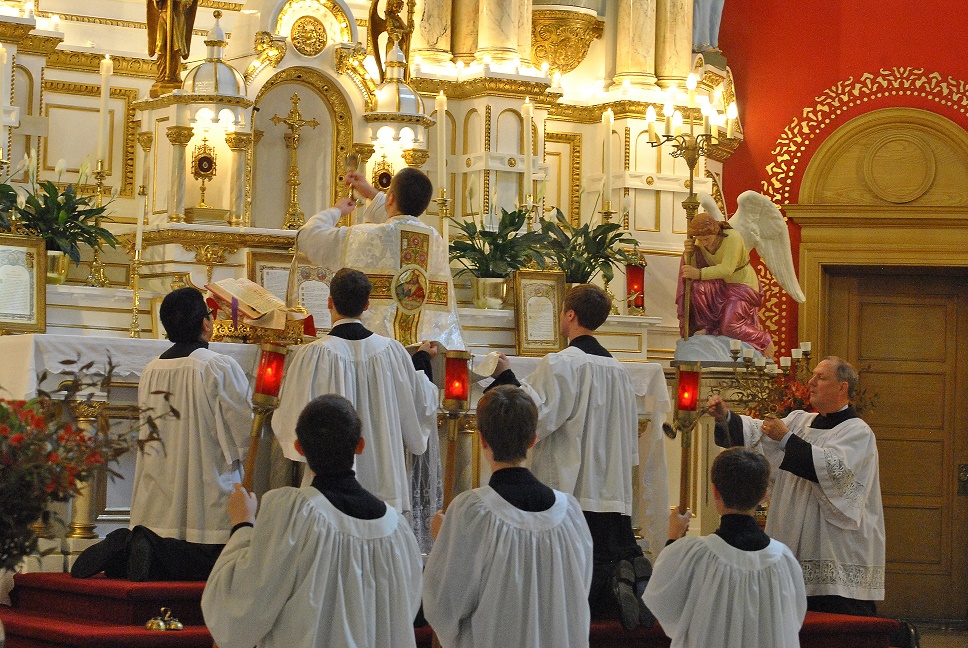St. Anthony’s Catholic Church is fortunate to celebrate Mass according to both the 1962 and 2002 editions of the Roman Missal. The 1962 edition is what is properly called the “Extraordinary Form” of the Roman Rite and popularly known as the “Tridentine Mass” or “Traditional Latin Mass”. The 2002 edition is known as the “Ordinary Form” of the Roman Rite or the “Novus Ordo Missae” (New Order of the Mass), and is the form of Mass celebrated in most Roman Catholic parishes today.
The Tridentine Mass, which was promulgated in 1570 by Pope St. Pius V after the Council of Trent (“Tridentine” means “pertaining to Trent”), underwent a number of minor revisions through the years. As celebrated today, the Tridentine Mass follows the edition of the Roman Missal promulgated by Pope St. John XXIII in 1962. After the Second Vatican Council (1962-1965), a much more thorough revision of the Roman Missal was completed in 1970. This revision implemented many changes in the way Mass was celebrated.
While many Catholics embraced these changes enthusiastically, some preferred the beauty, reverence, liturgical poetry, and profound expressions of holy truths of the usus antiquior (ancient rite), and so Pope St. John Paul II gave permission in 1984 — and widened this permission in 1988 — for it to be celebrated in those dioceses whose bishop permitted it.
On July 7, 2007, in the Apostolic Letter Summorum Pontificum, Pope Emeritus Benedict XVI widened permission for the Latin Mass to be offered by parish priests for any stable group within the Church requesting worship according to the 1962 Missal. This letter replaces the Apostolic Letter Ecclesia Dei of 1988, and its issuance is a most encouraging development i the liturgical life of the Church.
In July 2007, Msgr. Frank Chiodo, pastor at St. Anthony’s Catholic Church, began celebrated the Extraordinary Form and has celebrated it weekly ever since. Additionally, on certain feasts, he also celebrates the Mass which he holds near and dear to his heart.
Why is Latin the Church’s official language?
When the apostles first carried Christ’s Good News to the world, they traveled throughout the Roman Empire, which governed most of the lands around the Mediterranean Sea and in western Europe. Since the Romans spoke Latin, this language was once used by many people at that time, much as today many people in the world know English because it is economically and socially advantageous. As the Roman Empire disintegrated in the 4th and 5th centuries, the emerging Church, led by the Bishop of Rome, stepped in to provide a stabilizing cultural force, and through the centuries has retained the use of Latin in official communications as a means to unity.
The Latin language is the national property of no one people, yet, through learning, can be common to all. This feature makes it especially appropriate for a universal Church. The use of Latin by the Church started as a happenstance of history and geography, but has enabled the Church to maintain unity amidst the disciples she has made of all nations.
(Excerpts taken and adapted from Holy Rosary Catholic Church, Indianapolis, IN)

Wendy Ogden
Thank you for this lovely explanation of the traditional Latin Mass. We are very blessed to have the opportunity to experience it every week here in Des Moines.
admin
Thanks, Wendy! We welcome your feedback and suggestions on how to continue to promote the EF in Des Moines!
Barbara Arkwright
I treasure my “Saint Joseph Daily Missal” given to me at age 14, in 1953 by my parents. The calendar of readings is through 1996. I continue to read and pray from it during the seasons of Advent and Lent. It contains prayers of the rosary and standard prayers. It lists Saints feast days. It draws me to daily prayer.
admin
Thanks for sharing, Barb! Maybe you’ll be able to join us on Saturday, Sept 30th at the Basilica for a Day of Recollection: https://www.unavocedsm.org/Cassian.